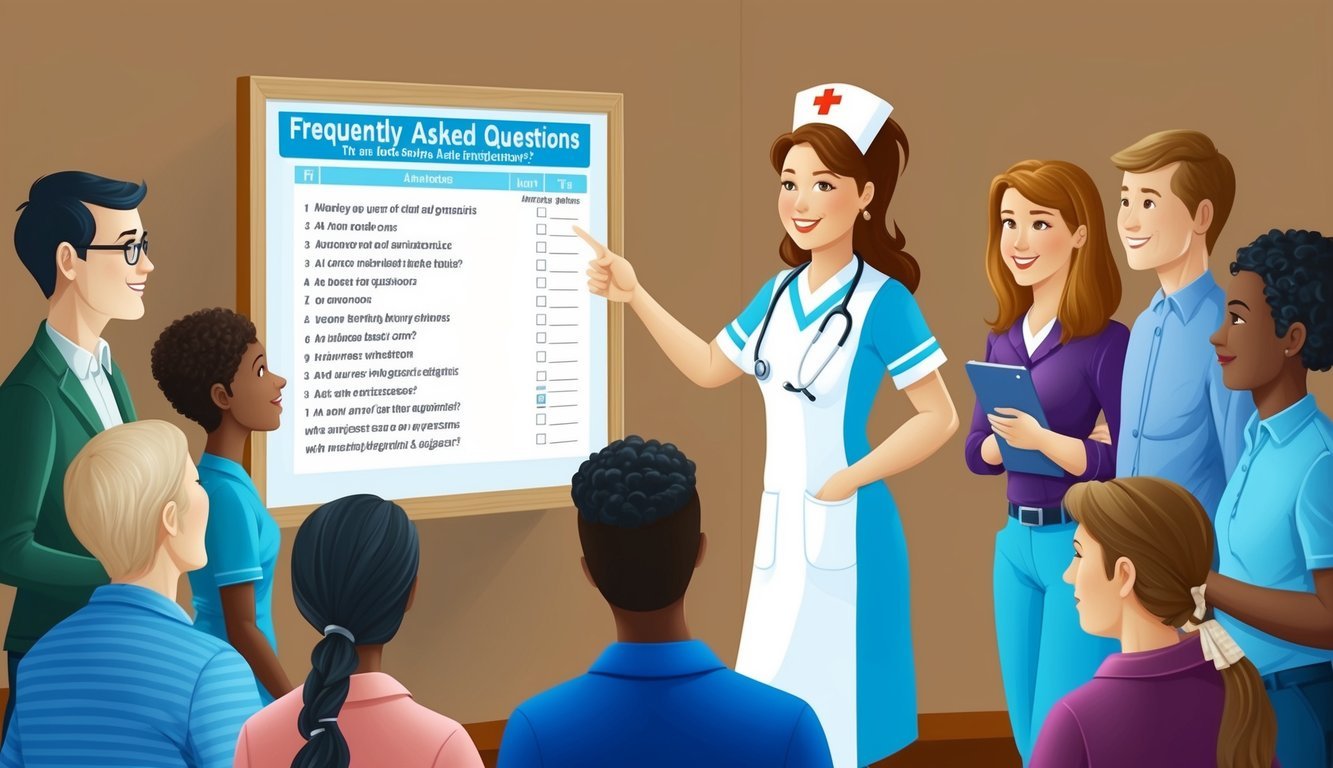Nursing diagnosis is a crucial part of patient care that helps guide treatment plans and interventions.
Identifying a patient’s health issues allows you to create a specific care plan that addresses their individual needs.
Understanding nursing diagnosis not only enhances your skills but also improves patient outcomes through informed and evidence-based practices.
You will encounter various types of nursing diagnoses, classified under guidelines set by NANDA-I. From actual diagnoses to potential ones, recognizing the differences will better prepare you to serve your patients effectively.
Being equipped with this knowledge lays the foundation for delivering comprehensive, ethical, and high-quality nursing care.
Key Takeaways
- Nursing diagnoses help identify patient health issues for effective care plans.
- NANDA-I provides a structured classification of nursing diagnoses.
- Understanding these diagnoses is essential for improving patient outcomes.
Foundations of Nursing Diagnosis
Understanding nursing diagnosis is crucial for effective patient care.
This section covers key concepts, various definitions, and established classification systems that help structure nursing diagnoses.
Concepts and Definitions
A nursing diagnosis identifies health issues and determines appropriate care.
It differs from a medical diagnosis, which remains in the patient’s history.
Nursing diagnoses focus on problems that nurses can address through interventions.
You may encounter definitions from NANDA International, which is the primary organization that standardizes nursing diagnoses.
For example, NANDA defines a nursing diagnosis as “a clinical judgment about individual, family, or community responses to actual or potential health problems.” This definition emphasizes the role of nurses in assessing and responding to various patient needs.
Accurate nursing diagnoses guide care plans and improve patient outcomes.
Classification Systems
Classification systems are essential for organizing nursing diagnoses.
NANDA International developed a taxonomy that categorizes these diagnoses into domains and classes.
This structure helps you find relevant diagnoses based on specific patient conditions.
Here’s a basic overview of the NANDA taxonomy:
| Domain | Example Class | Typical Diagnoses |
|---|---|---|
| Health Promotion | Nutrition | Readiness for enhanced nutrition |
| Risk | Risk for infection | Risk for injury |
| Actual | Acute pain | Ineffective breathing pattern |
Using these classification systems can improve communication and consistency in nursing practice.
Familiarizing yourself with these terms ensures that you provide targeted and effective care for your patients.
For further details, you can refer to resources like the NANDA International website.
The Nursing Process

The nursing process is a systematic method that helps nurses deliver effective care.
It consists of several key steps: assessment, diagnosis, planning, implementation, and evaluation.
Each step plays a crucial role in ensuring that patient needs are met comprehensively.
Assessment and Data Collection
In the assessment phase, you gather information about the patient’s health status.
This includes a thorough physical examination, health history, and environmental factors.
Various tools and techniques can be used, such as interviews, observations, and diagnostic tests.
Effective assessment can include:
- Health History: Collecting details about past illnesses, surgeries, and family health.
- Physical Exam: Observing vital signs, respiratory patterns, and other physical indicators.
- Diagnostic Tests: Reviewing lab results or imaging studies.
This information helps you identify any immediate health concerns and forms the basis for the nursing diagnosis.
Diagnosis and Clinical Judgment
The diagnosis phase involves interpreting the data collected during assessment.
You make clinical judgments about the patient’s needs and establish nursing diagnoses.
Each diagnosis describes a specific health problem or potential risk.
Nursing diagnoses can cover areas such as:
- Health Promotion: Encouraging healthy behaviors.
- Risk Factors: Identifying potential health threats.
- Actual Problems: Addressing existing health issues.
These diagnoses guide the planning phase, where you develop a targeted approach to care.
Planning and Outcome Identification
In the planning phase, you create a care plan based on the nursing diagnoses.
This plan should be individualized and include measurable goals that are realistic and achievable.
Collaborating with the patient and their family can enhance the planning process.
Key components of planning include:
- Specific Goals: Clearly defined outcomes, such as improving mobility.
- Interventions: Specific actions to address each diagnosis.
- Time Frames: Setting realistic timelines for achieving goals.
By outlining a clear plan, you ensure that all actions taken are purposeful and focused on improving patient well-being.
Implementation of Nursing Interventions
Implementation occurs when you put the care plan into action.
This step involves carrying out the nursing interventions as outlined.
You may work independently or in collaboration with other health professionals.
Key aspects of implementation include:
- Administering Treatments: This may involve medications, therapies, or educational sessions.
- Monitoring: Keeping an eye on the patient’s response to interventions.
- Adaptation: Modifying interventions based on patient reactions or changing conditions.
Your careful execution of these interventions is critical to achieving the planned outcomes.
Evaluation of Patient Outcomes
In the evaluation phase, you assess whether the patient’s goals have been met.
This involves reviewing the effectiveness of the nursing interventions and making adjustments if necessary.
Evaluation includes:
- Measuring Outcomes: Checking if the set goals are achieved.
- Patient Feedback: Listening to the patient’s experience and satisfaction.
- Revising Plans: Adjusting the care plan as needed for continuous improvement.
Developing a Nursing Care Plan
Creating a nursing care plan is essential for providing structured patient care.
This process involves linking nursing diagnoses to expected outcomes, prioritizing interventions, and documenting the care plan effectively.
Linking Diagnosis to Outcomes
Begin by connecting each nursing diagnosis to specific expected outcomes.
Identify what you want to achieve for the patient based on their unique needs.
For instance, if the diagnosis is “Impaired Gas Exchange,” an expected outcome may be “Patient will demonstrate effective breathing patterns within 48 hours.”
Use this format to guide your planning:
| Nursing Diagnosis | Expected Outcome |
|---|---|
| Impaired Gas Exchange | Patient will maintain oxygen saturation above 95% |
| Ineffective Breathing Pattern | Patient will report improved comfort levels |
Ensure your expected outcomes are SMART: Specific, Measurable, Achievable, Relevant, and Time-bound.
Prioritizing Nursing Interventions
Next, determine the most critical interventions for each diagnosis.
Rank these interventions based on patient safety and urgency.
For example, airway management should always take precedence over less immediate concerns, like mobility enhancement.
You can categorize interventions into three levels:
- High-Priority Interventions: Must be addressed first for safety.
- Medium-Priority Interventions: Important but not immediately life-threatening.
- Low-Priority Interventions: Addressed after urgent needs are met.
Creating a clear list helps in focusing on what matters most to your patient’s recovery.
Documenting the Care Plan
Documentation is crucial in nursing care plans.
Be clear and concise in writing down your planned interventions, expected outcomes, and actual patient responses.
This ensures continuity of care and provides vital information for other healthcare providers.
Here’s what to include in your documentation:
- Patient Information: Demographics and relevant medical history.
- Nursing Diagnoses: Clearly stated with corresponding expected outcomes.
- Interventions: List each intervention with a timeline.
- Evaluation: Record whether the expected outcomes were met.
Good documentation reflects your commitment to quality care and enhances communication within the healthcare team.
Properly managing documentation supports patient safety and optimizes outcomes.
For more guidance on nursing care plans, you can explore additional resources.
Types of Nursing Diagnoses
Nursing diagnoses are categorized based on the nature of the health issue.
Understanding these types helps you identify patient needs, plan care effectively, and evaluate outcomes.
The main types include problem-focused, risk, health promotion, and syndrome diagnoses.
Problem-Focused Diagnoses
A problem-focused diagnosis addresses a current health issue experienced by the patient.
It focuses on the patient’s response to a diagnosed condition.
For example, if a patient has chronic pain, the nursing diagnosis might include “Chronic Pain.”
Characteristics:
- Identified Problems: These diagnoses highlight specific issues like pain, mobility restrictions, or anxiety.
- Assessment Data: Use subjective data (patient reports) and objective data (observations) to form the diagnosis.
An example includes diagnosing a patient with “Impaired mobility related to pain as evidenced by the patient’s report of 8 out of 10 on the pain scale.” More information can be found in this Nursing Diagnosis Guide.
Risk Diagnoses
Risk diagnoses identify conditions that may develop in a patient due to certain risk factors.
These factors can include age, medical history, or lifestyle choices.
Key Points:
- These diagnoses are proactive, aiming to prevent potential health issues from occurring.
- An example is “Risk for Infection related to surgical incision.”
Understanding risk factors helps you create prevention plans.
It is essential to assess patient’s situations closely to identify these risks effectively.
For details, see the Nursing Diagnosis Guide for 2024.
Health Promotion Diagnoses
Health promotion diagnoses focus on the patient’s readiness to enhance health and well-being.
They target areas for improvement, encouraging patients to adopt healthier behaviors.
Examples of Health Promotion Diagnoses:
- “Readiness for Enhanced Nutrition.”
- “Readiness for Enhanced Self-Care.”
You can assess a patient’s willingness and readiness through direct questions or discussions about their goals.
This approach fosters positive changes in lifestyle and health.
For additional insights, visit Nursing Diagnosis Guide.
Syndrome Diagnoses
Syndrome diagnoses relate to a cluster of signs and symptoms that suggest a specific syndrome.
They provide a broader context for understanding a patient’s condition.
Examples include:
- “Post-Trauma Syndrome.”
- “Disuse Syndrome.”
These diagnoses help in creating comprehensive care plans aimed at multiple symptoms and issues simultaneously.
As you work with patients, recognize the connection between symptoms and the syndrome for effective care management.
More information can be found at Nursing Diagnosis Guide.
Navigating Ethical Considerations
In nursing practice, ethical considerations play a crucial role in patient care.
You must balance clinical judgment with the need to respect patients’ rights.
Understanding the intricacies of maintaining patient privacy, embracing cultural sensitivity, and the ethical use of standardized classifications is essential for effective nursing diagnosis.
Maintaining Patient Privacy
Patient privacy is a cornerstone of nursing ethics.
You are responsible for protecting sensitive information while providing care.
This involves:
- Confidentiality: Keep patient information private and share it only with authorized individuals.
- Informed Consent: Ensure patients understand what information will be shared and why.
Using secure electronic health records can help maintain confidentiality.
Make sure that any discussions about patient care occur in private settings.
When documenting a nursing diagnosis, avoid including personal identifiers to protect patient anonymity.
Cultural Sensitivity in Nursing Diagnosis
Cultural sensitivity is vital in delivering appropriate patient care.
Recognizing and respecting diverse cultural backgrounds help in forming accurate nursing diagnoses.
Key aspects include:
- Awareness: Understand cultural differences that may affect patient behavior.
- Communication: Use language and terminology that befits the patient’s cultural context.
You should actively engage patients in their care planning.
Ask about their cultural preferences and beliefs, which can guide your clinical judgment.
This approach enhances patient safety by fostering trust and improving health outcomes.
Ethical Use of Standardized Classifications
Standardized classifications, such as the North American Nursing Diagnosis Association (NANDA), help in structuring nursing diagnoses.
However, ethical use is crucial.
Consider these points:
- Adaptation: Tailor standardized diagnoses to fit individual patient needs.
- Relevance: Use classifications that accurately reflect the patient’s condition.
Incorporating clinical judgment while using these classifications will support comprehensive patient assessments.
Always document any deviations from standardized diagnoses, providing a rationale for your choices to ensure transparency in your nursing practice.
This practice fosters accountability and enhances patient safety.
Special Considerations in Nursing Diagnosis

When you assess patients, it’s essential to consider the context of their conditions.
Special considerations in nursing diagnosis can significantly impact patient outcomes.
This includes unique needs arising from chronic conditions, acute situations, and variations in age groups.
Chronic Conditions and Long-term Care
In patients with chronic conditions like heart failure or chronic pain, nursing diagnoses must reflect ongoing health issues.
These conditions often require careful monitoring and adjustment of care plans.
Key points to consider:
- Related Factors: Look for signs of fluid retention, breathing difficulties, or fatigue in heart failure patients.
- Etiology: Assess how lifestyle factors, such as diet or exercise, may contribute to the illness.
- Goals: Focus on managing symptoms and improving quality of life.
Developing an effective diagnosis will often involve collaboration with a multidisciplinary team.
Resources for managing chronic conditions can be found at Nurse.org.
Emergency and Acute Care Settings
In emergency and acute care, timely nursing diagnoses are crucial.
You often deal with rapid changes in patient status, such as after a stroke or during a heart attack.
Quick and accurate assessment can save lives.
When diagnosing, prioritize:
- Immediate Needs: Assess vital signs and any obvious trauma.
- Risk Factors: Identify those at high risk for complications, including history of strokes or heart issues.
- Interventions: Plan interventions that stabilize the patient first before broader assessments.
In these settings, relying on protocols can help streamline the decision-making process.
For more information on emergency nursing practices, visit Nurse.com.
Pediatric and Geriatric Populations
Both pediatric and geriatric patients present unique challenges for nursing diagnosis.
Each age group has specific needs that affect how you assess and treat them.
For children:
- Developmental Considerations: Pay attention to growth patterns and developmental milestones.
- Family Involvement: Engage parents for accurate history and support during assessments.
For older adults:
- Comorbidities: Recognize that they may have multiple health issues, complicating diagnosis.
- Sensory Changes: Take into account age-related changes, such as decreased vision or hearing.
Considering these factors will help you create a more accurate and comprehensive nursing diagnosis.
Further resources for these populations can be explored at Nurseslabs.
Frequently Asked Questions

This section addresses key questions about nursing diagnosis, providing clarity on components, differences from medical diagnosis, types, formulation steps, updates, and resources.
Each answer aims to enhance your understanding of nursing diagnosis in clinical practice.
What are common components of a three-part nursing diagnosis?
A three-part nursing diagnosis typically includes the following components:
- Problem Statement: This identifies the patient’s health issue.
- Related Factors: These are the causes or risk factors linked to the problem.
- Defining Characteristics: These are the signs and symptoms that support the diagnosis.
How is a nursing diagnosis different from a medical diagnosis?
A nursing diagnosis focuses on the patient’s responses to health issues, while a medical diagnosis identifies specific diseases or conditions.
Nursing diagnoses guide nursing interventions and care plans, emphasizing holistic patient care.
Can you provide a summary of the four types of nursing diagnosis?
The four types of nursing diagnoses are:
- Actual Diagnosis: Indicates a current health issue, like pain or impaired mobility.
- Risk Diagnosis: Identifies potential health problems, such as risk for infection.
- Wellness Diagnosis: Focuses on a patient’s readiness for enhancement, like readiness for enhanced nutrition.
- Syndrome Diagnosis: Refers to a cluster of diagnoses that occur together, such as post-trauma syndrome.
What are the steps in formulating a nursing diagnosis according to NANDA International?
The steps include:
- Assessment: Collect pertinent data from the patient.
- Diagnosis: Analyze the data to identify patterns and form hypotheses.
- Validation: Confirm the diagnosis with the patient.
- Documentation: Write the nursing diagnosis clearly and accurately.
How often is the NANDA nursing diagnosis list updated?
The NANDA nursing diagnosis list is updated every two years.
This regular revision ensures that the diagnoses reflect current practices and emerging evidence in nursing care.
Where can you find legitimate resources for NANDA nursing diagnosis education?
You can find reliable resources through sites like NANDA International and nursing education platforms such as Nurseslabs.
These sites offer comprehensive guides and updates on nursing diagnosis.

